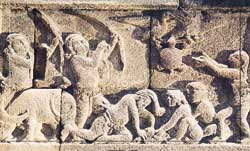Candi Mendut is located on the most east of the line of three temples; Borobudur Temple, Pawon Temple and Mendhut Temple. This temple was built by Syailendra dynasty and typical of Buddhist Temple that was proven by 48 bell-like stupas on its heading. There was no information when this temple was erected but a Dutch archeolog mentioned inscription dated 824 , that King Indra built a sacred building called venunava. And a Budhist Priest Bhiku Sri Pannyavaro Mahathera said that the original name of the temple is Venuvana Mandira that means a palace bamboo forest. So probably the temple was built in 8th century.
In the inner part of the temple located altar where 3 Buddha statuary standing calmly, they are Bodhisattva Vajravani, Buddha Sakyamuni and Bodhisattva Avalokitesvara. Those three statuary are stiil in good condition, and often Buddha believers or local people put offering and incense on their feet.
Chronologically, Candi Mendut was discovered in 1836 then revovated in 1897 and 1904. In 1908 it was restored again to perfect the header section and in 1925 all the stupas are completely restored. Until today the head of this temple is not completely restored. When first disvovered it was covered by soil and bush, and it was estimated to be destroyed by Mt Merapi eruption in 1006.
This Buddhist temple has very enticing reliefs that emblazon the outside panel of wings stairways of the temple. The reliefs are fable or Jataka tales that have moral message and causative effect. Relief on the left side is about turtle that is in danger and it is saved by 2 cranes, and the cranes asked turtle to bite a branch of tree and the cranes hold the ends of the branch and fly. The cranes asks the turtle to remain silence and bite the branch while they are in the air. On the way, they pass wolves that saw them flying and one of them said ” Look, two cranes are flying with a turtle”, the other said “that was not turtle, but a cow manure”. Turtle can hear their conversation and is angry and wants to defend itself and forgot that he is in the air. The turtle releases its bite and it falls to the ground and died. Other fabels in the reliefs are crab and a priest, elephant and priests, monkey and crocodile, and many more.
On the right entrance way of the temple depicted Kuvera relief that tells story about Kuwers, the God of Wealth, that loves and protect kids after encounter with Buddha, then he is a mean giant that eat men. On the left side of the entrance way, depicted Hariti who was a canibal, but after meeting Budha, she protects children and even more she is also known as Goddess of Fertility.
 Mendut is also known as temple that shines holiness light from the three statuary. Budhist consider this temple as a place to pray to God, where God will grant prayers not only by local people but also foreigners. in 1980s a Japanese prayed here for her son recovery from severe sickness. For the recovery of her son she built monument of copper and Merapi andesit written in Japanese.
Mendut is also known as temple that shines holiness light from the three statuary. Budhist consider this temple as a place to pray to God, where God will grant prayers not only by local people but also foreigners. in 1980s a Japanese prayed here for her son recovery from severe sickness. For the recovery of her son she built monument of copper and Merapi andesit written in Japanese.
According to Caesar Voute in his book ‘Borobudur and Its Meaning’, Mendut is located on an imaginary line from west to east 3 km accross Progo and Elo River that connects 3 temples, Borobudur, Pawon and Mendut. Candi pawon to candi Mendut is 1.150 m away and candi Pawon to Candi Borobudur is 1.1750 m away. Archaeologs compare the geography of the area to gangga and yamuna in India.
